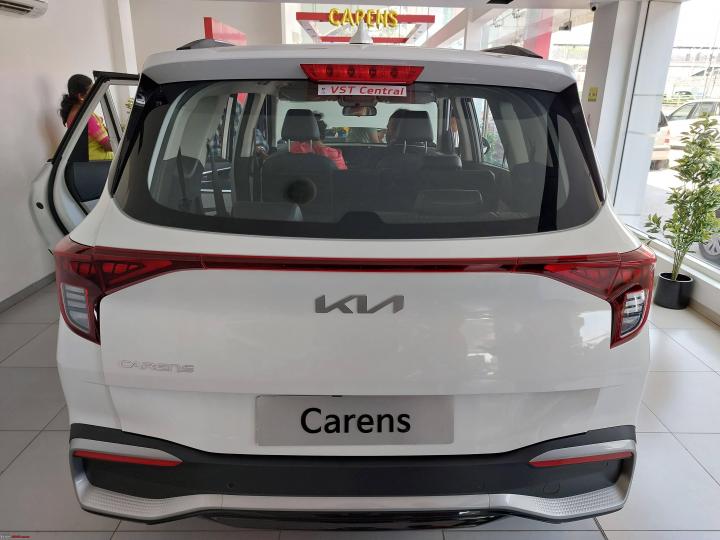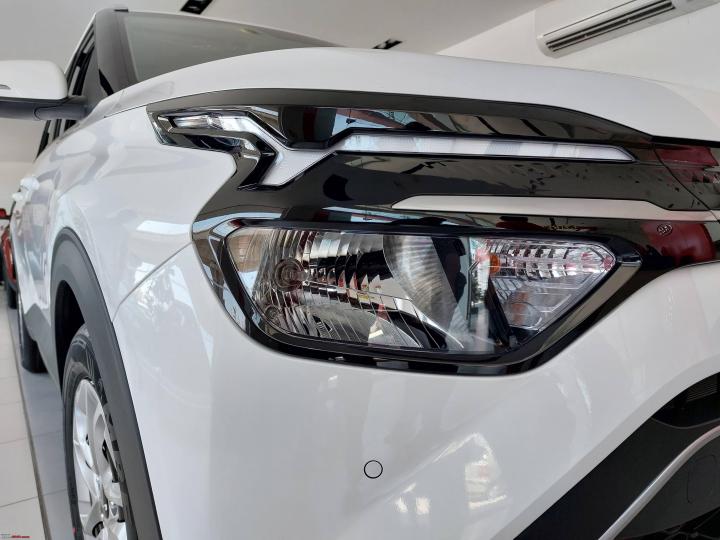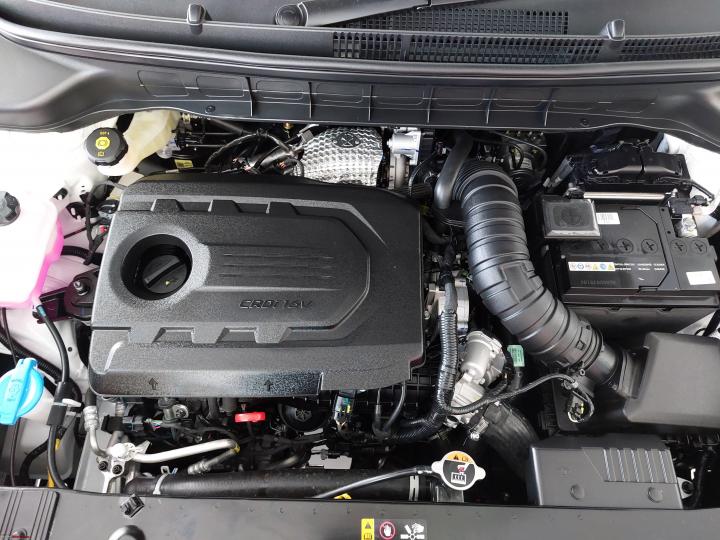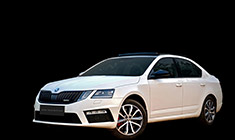News
Kia Carens diesel MT: Impressions after a weekend of driving
A top class product. Kia's hit it out of the park with the Carens.
GTO recently shared this with other enthusiasts.
Spent the weekend with the Kia Carens and absolutely loved it . I respect what Kia is doing with its product range and how they're putting so much thought into their cars. Am a fan of the Carnival, Sonet, Seltos (GNCAP aside) and now, the Carens.
Excellent ride quality (this is important to me) + space packaging + useable 3rd seat row + dashboard design + features + front styling. I love that funky face! I got the Diesel MT and found it practical as well as efficient. Power is adequate, but will be strictly okay with 7 people onboard. I foresee a lot of individual owners picking the Carens over the Innova Crysta. Reasons = as easy to drive as a Honda City or EcoSport (Innova requires more effort), cushy ride quality, smaller size makes it easier in the city, more fuel efficient and of course, significantly cheaper. Equally, I see a lot of people gravitating from the Ertiga / XL6 to the Carens because the Kia just feels so much better. Kia has smartly picked the sweet spot between the Ertiga / XL6 on the lower end and the big daddy Innova Crysta on the higher end. Something the Mahindra fellows could just never do with the very competent Marazzo. We saw this same kind of brilliance at the time of the Seltos' launch too. The marketing & product team @ Kia is full of geniuses. Am not kidding.
A top class product. Kia's hit it out of the park with the Carens. Hyundai should learn = they royally messed up the Alcazar's packaging where neither the 2nd row nor 3rd row are good. The Alcazar didn't impress me at all, while the Carens has left me . The Kia Carens is going to the top of my recommendations list. I sure hope it doesn't get another poor rating in the GNCAP though; IMHO, the company's reputation took a body blow after the Seltos' poor showing in the crash tests and the entire company was shaken up. Kia won't make the same mistake again. But never know for sure until the actual GNCAP rating is out.
Unfortunately, like many other Hyundai-Kias I've driven in the last 4 years, this one too had a niggle / problem. The RHS driver speaker would intermittently cut off. I live on music and the constant up / down in volume was annoying on the highway drive. Hyundai-Kia really need to sort these production issues out.




Check out BHPian comments for more insights and information.
News
Purchase experience & initial ownership review: Kia Carens diesel AT
The introductory prices blew us away and I went straight home, picked up the family and drove down to the showroom with just one demand - give us the car.
BHPian PGNarain recently shared this with other enthusiasts.
So, as mentioned here already, we got our new Kia Carens delivered on Sunday, 13th March. I have been a member here for almost 10 years now, 3 cars and 2 two wheelers later, this will be my first Ownership Report and hope it ticks all the boxes! But first some background so please bear with me for the longish post!
I have few indulgences in life and like to think I lead a simple life, but car / two-wheeler buying for me have always been an impulse / emotional purchase. Though I will look around, I find that rarely my mind changes once a machine has made an impression, despite what logic or naysayers may say.
It all started with my first purchase, a RE Electra 350cc 4S which I bought 2nd hand in Delhi from the Karol Bagh Market. I was initially trying to apply my mind to the buying process and looked at several 150cc bikes (Unicorn, Pulsar etc), but just one short trip as a pillion (I had never been on a RE before - EVER) among the congested lanes of Karol Bagh with blessings of Hanuman Ji in the background, I knew that this is the bike I was meant to drive - period. My first car, the Linea followed a few years later after a single and very short test drive and despite all the FIAT bashing threads, I just knew I would not be happy with any other car. I was in two minds at one point, reading about the horror stories associated with a owning a Fiat Car but my wife simply told me - Buy it, otherwise for all time and whenever you see another Linea out on the road you will feel regret.
Boy, was it a good decision, we had some amazing times and after 9 glorious years we had no plans upgrading or changing the car, except for a small itch!! An expanding family and an ever-expanding waistline meant we were casually on the lookout for a bigger car. Enter MG and the MG Hector! I still remember it vividly when I first saw a Black Hector on the Pune by-pass, bearing down steadily in my rear-view mirror! That grill... ooh, it was love at first sight. I found it hard to believe that I had gotten so involved in my work and had no clue about the car / brand's launch whatsoever. Long story short, we took a test drive and if memory serves, we booked our Hector that very day. Now came the tough part, which was to sell or not to sell our beloved Linea. Being the only driver in the family, among other reasons, logic prevailed over the heart, and we had to let her go. Till today, i regret that decision and if you were to ask me my car registration number out of the blue, I would still probably rattle out our Linea's number plate. My wife who is hardly ever a car enthusiast cried when our car was taken away.
But I digress. We have been extremely happy with our Hector, and during the lockdown my wife learnt to drive and drive confidently enough in Mumbai traffic. This meant that now the same car was being driven by both of us, which was perfectly ok! But then the pandemic subsided, my office re-opened, albeit in a different location from pre-lockdown days. This meant I would now have to drive or face the vagaries of public transport. It was an easy but expensive choice and meant on an average we were spending about INR 20-22,000 per month on fuel. Coping with ever-rising fuel costs, consistently high per month running and unexpectedly long road trips. Just during the lockdowns we racked up +37,000kms within two years of our car purchase in Nov 2019. All this coupled with the fact that we now sorely needed a 2nd car in the family, had us on the lookout again, with no clear favourites.
This time we were clear that we needed a good mileage car, preferably a diesel and an automatic. Test drove a whole range of cars and following were the cars we tried out / considered:
- Maruti Suzuki Baleno: Was ok to drive and the showroom was willing to part with pre-facelifted Balenos in stock for a substantial discount before the new one was launched. But the car felt underpowered and tinny. Panels flexed liked mad, and the doors felt so lightweight and cheap. Also, Maruti didn’t have a diesel and an auto box wasn’t available in stock.
- Maruti S-Cross: Was a good drive and though the auto box was an age-old design, it worked well enough for us. However, again no diesels engines and the car just seemed a little too old and outdated.
- Hyundai i10, i20, Venue: All 3 were good offerings for the price but were too small for me personally. The family again just didn't bite at all and after the Hector, they found it too small. Embarrassingly during the test drives my daughter kept harping on how the car was too small, didnt have a panoramic sunroof etc etc in front of the service exec.
- Hyundai Creta: A genuine contender but none of us liked the looks. Also, we flet that the space was at a premium in the 2nd row.
- Tata Altroz, Nexon: Good cars but were severely let down by a pathetic showroom / sales experience. We also felt the space was not good enough in both the front and second rows for 5 persons.
- Tata Harrier: Amazing car but again severely let down by the showroom experience and the top end Diesel Auto was well beyond our budget.
- Tata Safari and Toyota Innova were not considered because they were too big for our parking space and the well kitted out trims were too big for our wallets.
- Polo TSI: Great to drive and still looks good from the outside. On the inside is a different story, thought the interior aged well but it was just too small, too expensive and way to long in the tooth now. I tried it out solely because I think it is still a great car and fun to drive.
- MG Hector, Hector Plus: Nice cars, but we didn’t like it to the extent to buy a 2nd Hector. Also the Diesel was well beyond our budget and our parking would just not accommodate such a big car!
- Jeep Compass: A nice car but the diesel auto was way out of our budget, not even worth considering. Did not even take a test drive.
- VW Vento: Overall a great car but lacked a diesel. Also, we were not inclined to go back to a sedan and why we didn't consider the Honda City, Verna or the Rapid or Slavia.
- VW Taigun: both 1ltr and 1.5ltr: Beautiful car, nice build quality, lovely interiors and the 1.5TSI was an amazing drive. But again, no diesel and it didn't really feel like an upgrade from the Hector or even in the same category somehow. The family too just wrote it off completely.
The VW and KIA showrooms are adjacent to each other here in Navi Mumbai and I happened to see the Carens. The test drive cars were in Aurora Black, and I instantly took a liking for it. Crossed the road, asked for a test drive on what seemed to be a busy day. The showroom people were very receptive. We were promptly attended to, a far far far cry from the Tata Showroom and were asked to wait till the test drive vehicles came back. In the meantime the service advisor offered us tea / coffee and my daughter was given a Kia Carens colouring sheet with colours to keep her busy while the service exec took us through the trims, features etc. Though we had already made up mind for the diesel auto, we test drove the petrol 1.4 DCT as well.
My wife test drove the petrol and came away very impressed. I sat behind in the captain seats and loved every minute of it. My daughter had a ball of a time jumping between the last row and 2nd row. Next up was the diesel auto (7-seater), which I test drove and had decent drive of about 4-5kms. By the end, my mind was all but made up. Once we got back, the service exec got busy showing us the features and I simply told her - leave it, just book it! Following details and price break up shared at the time:
Model - Kia Carens D 1.5CRDI VGT 6AT Luxury-Plus 6 seater.
- Ex-showroom: INR 16,99,990/-
- TCS: INR 16,999/-
- RTO: INR 2,45,296/-
- Insurance: INR 64,736/-
- Total: INR 20,27,021
- Add Optional EW + Care Package: INR 50,000
- Total OTR: INR 20,77,021
This was on Sunday evening, 13th of Feb and two days before the price reveal. Me and my wife decided that if the ex-showroom price for the top end diesel would be around 18, we would buy the Carens. On the day of the price reveal, I locked myself in a conference room in my office and waited with bated breath. The introductory prices blew us away and I went straight home, picked up the family and drove down to the showroom with just one demand - give us the car.
Our service exec assured us that she would manage delivery latest by the end of March or by early April. I told her that my wife's birthday is in the 1st week of April, and this would make a lovely present. She assured us that she would be able to make it happen and asked us to apply for our loan, which we promptly did and got the loan sanctioned soon thereafter. As luck would have it, my wife called me one fine evening early March saying that the showroom had a an allotment for our car and could get us delivery by 10/11 March if we could manage the payments etc. We immediately confirmed but asked for the delivery to be made on Sunday, 13th March as we had plans to travel in the 2nd half the same week.
However, tragedy struck, my daughter broke her arm exactly one week before the planned delivery and everything went awry. I could not do the PDI at the stockyard, nor explore or negotiate on the insurance etc. Plans to try and apply for a BH registration number also fell through. Our travel plans were shelved and though we could take an early delivery, but between loan disbursement delays, multiple hospital rounds, office duties etc meant that delivery would at the earliest be on Saturday, 12th. Saturday delivery was struck down since my wife didn’t want to buy metal on a Saturday (shani etc). So, Sunday the 13th of March it was...

We completed the delivery formalities and paperwork. Gifted our KIA RM a box of sweets and a small gift which was followed by a very nice hand over ceremony by the Kia showroom staff and they also gave us a lovely set of 4 coffee mugs, which was very thoughtful and frankly amazing:

The final price and break up is as follows with the invoice copies also:
- Ex-showroom: INR 16,99,990/-
- TCS: INR 16,999/-
- RTO: INR 2,45,296/-
- Insurance: INR 61,642/-
- Fast Tag: INR 500/-
- Total: INR 20,24,427/-
- Add Optional EW + Care Package: INR 50,000
- Total OTR: INR 20,74,427/-
Tax invoice:

Insurance, RTO, Fast Tag, TCS:

Kia Convenience Package for 5 years:

Straight out of the showroom we drove down to the nearest petrol pump and filled up a small amount of Diesel and headed for a celebratory lunch with our friends. In the evening I dropped off the Carens to the Nerul 3M workshop for the following treatments:
- PPF for the entire car, including bonnet and roof: INR 92,250/-
- Sunfilm, including fore and aft windshields: INR 30,424
- 3M Mats: INR 9,600/-
- Underbody Anti Rust: INR 5,212/-
- Anti Rust Silencer Treatment: INR 1,186/-
We managed to wriggle some discounts and finally settled the bill rounded off to INR 130,000/-
Got the car back on Wednesday evening finally, shining and sparkling in all glory:






The Carens has been immediately been put into service and I drove her down to my office on the Thursday, just before the long Holi weekend starting Friday. I was very curious about the fuel economy and got a MID indicated economy of 14.4kmpl. This was driving through really bad traffic in the evening, with everyone heading out of Mumbai before the long weekend. Have a look at the situation below.
I took the below screenshot before starting from office but eventually the route had become far more congested by the time I transited:

The corresponding screen grab from my Kia Connect App for the same period:

And a shot of the MID for the trip. Do note that the car was driven the entire time in the default City Mode:

The upcoming weekend we took the opportunity to try out the Carens on the Lonavala ghats to ascertain the power delivery with a full load of 4 adults and 2 children and the corresponding fuel economy. I asked my friend and his family to join for the experiment and headed to Kinara Dhaba on the old Mumbai - Pune highway for lunch.
Tanked up the car to auto-cut off with normal diesel (oh tis so sweet to pay for fuel below 100 rupees...):

Tanked up again to auto-cutoff while returning:

Distance done between refills was 137kms and yielded a kmpl of 16.74kmpl as against a MID indicated figure of 16.50kmpl - pretty close and accurate. AC was on all the time and the engine remained in the default City Mode with few short bursts using the Sports Mode, especially while going up the ghats. We did not get much traffic, except for a few stretches in between, barring which it was very smooth sailing.
Driving experience:
Since delivery have completed 450kms and this is my first owned diesel Car and though I have driven diesel mills before, I haven't driven one in the past 2-3 years. A disclaimer that a lot of my impressions will be in comparison to the Hector and the Linea, which maybe helpful to some but in the end are prejudiced nonetheless.
The car has a good amount of low end torque, which I felt helps mask the initial lag, but it does still feel just that little bit lethargic moving from a standstill, especially on inclines and more so with a full load of people. However, it is far far better than what I face in the Hector but not even close to the sprightly Linea TJet. My friend who drives a Hyundai Xcent too mentioned he felt the same after driving our Carens. Once the car is past 1400rpm, it is very eager and feel more than adequate. During our run up the Lonavala Ghats, I frequently resorted to using the sports mode to get the engine gunning a little faster and which makes a substantial difference. In daily runs to office, I now use use the Sports Mode like launch control at traffic lights, driving otherwise in the City Mode for the rest of the time. This is not to say at all that the car feels underpowered, which it isn't at all, but to me it just feels a little bit heavy, a little lazy at very low rpms and this behavior accentuated itself on the ghat sections with a full load of people. In Eco mode, the Carens is significantly slower and is IMHO best left to long highway runs. I found the Eco Mode useless in city and have hardly ever used it, relying more on City and Sports Modes.
Handling:
The Carens handles well and feels very stable and planted at 100kmhr+ speeds on straight highways but it is certainly no corner carver. A few high speed turns gave me the goosebumps and have decided to lay off till i develop more confidence in the car. One issue I am facing is that I feel the car continually understeers. Not sure if this is normal given a heavier Diesel Engine upfront or for some other reason. Though this is hardly a major issue, it feels very different after driving the Hector and is no comparison to the Linea, which was in a different league altogether. Rest all is great, the car is big on the inside and not so big on the outside, so parking and squeezing into tight spaces is now much easier.
NVH, ride and comfort:
This is a a BIG plus point for the Carens. The ride is very comfortable and not floaty or unsettling. I can confidently say that the ride is better than the Hector over good, bad, ugly roads, though suspension travel on deep bumps will probably be less than it is on the Hector. On our lunch trip to Lonavala, it was the children who hijacked the middle row seats to and fro, while the moms were relegated to the last row. However, both Moms said it was very comfortable and in fact my wife snoozed all the way back after lunch. Her friend is given to motion sickness, too had no issues at all. NVH levels are remarkable and the car is very quiet and does an amazing job of insulating everyone from the outside world. Our Hector is a very silent car and the Carens with a diesel engine is right up there with only a slight vibrations reminding that this is not a petrol engine. Seats are a bit soft but super comfy in all three rows and the seat ventilation function is out of this world. It is now probably a must have feature in all my future purchases!
Other points - Likes and dislikes:
- BIG LIKE - Bragging rights like no other for the time being. In the 10 days we have had the Carens, I have just seen exactly one more Carens on the road other than mine!
- But compared to the Hector, the Carens misses out on street cred and sheer presence. In black, it looks even more diminutive and I felt doesn't attract eyeballs like the Hector did and still does.
- Ample storage spaces in the car and ergonomics are spot on, far better than the Hector and way better than the Linea. One sore point is that though the bottle holders in the doors will hold a 1 litre bottle easily, the top or the bottle cap sits outside the armrest bottom and tends to rubs against the side of my knee. A picture below to better illustrate the problem.
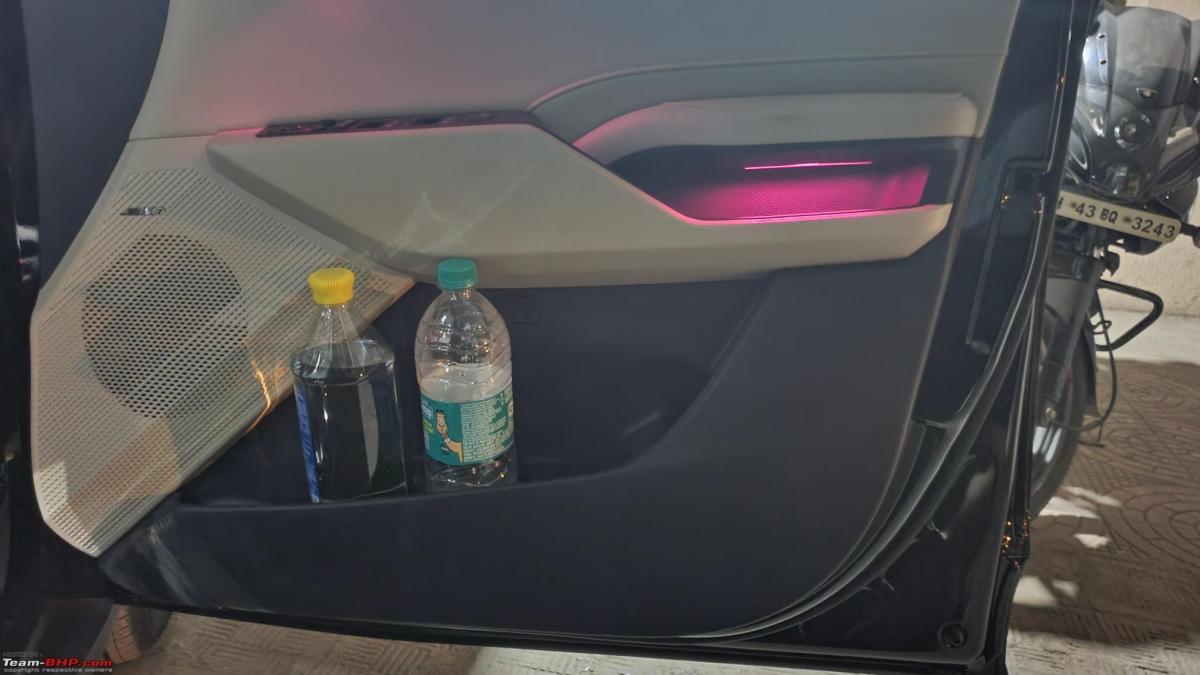
- Physical buttons, oh you sweet sweet sweet physical buttons, i love you! I sorely missed physicals buttons in the Hector for basic functionality towards the ACC, Radio, Infotainment Shortcuts etc and it is so great to have it all back. Moreover the use of metal and knurled finishes on the vents, ACC fan and Temp controls and steering controls feels awesome. It was the one thing that really caught my eye during the test drive.
- ACC is a chiller and took no time to cool down the cabin, even when parked in the sun for 2-3 hours.
- The steering Volume controls feel small for my fingers, and I have often ended up muting music while trying to raise the volume.
- The horn has an absolutely annoying "clack" sound each time you press it and is possibly the worst thing in this car. I do get some other minor sounds as well - my goggles rattle in the sunglass holder even though it is felt lined, the passenger side seatbelt bumps against the B pillar when not in use and going over rough roads and the tyre change tool kit in the dicky will clang together while going over bumps, though this was a quick fix once we arranged it.
- The ORVMs are the same size as the Hector but are better shaped and I felt give a better view behind. ORVM Controls are however not backlit which is surely a miss.
- Dead pedal is perfectly sized and positioned.
- Storage try under the front passenger seat is very nifty and useful.
- Exterior and Interior panels and materials feel very good, but do flex and at times a bit too much. For eg - the door panel visibly flexes while opening and closing the windows.
- Interior ambient lighting looks uber cool at night.
- Damped movement of the coin tray, bottle holder feels very premium but at the same time the totally undamped "khut opening" of the glove box is a downer.
Thanks for reading. I guess I have covered all that I had to say and do let me know if anyone has any queries.
Check out BHPian comments for more insights and information.
News
The ideal two car garage on a budget
My two are vastly different, and are literally from different planets. But they charmingly complement and complete each other very well.
BHPian vigneshkumar31 recently shared this with other enthusiasts.
One car do all?
The first and the obvious question before jumping into the rabbit hole of a two car garage is whether One car could indeed, do all?
Why pay insurance, and maintenance on two depreciating assets when a single set of wheels could roll into any role you want?
If we ponder about which kind of cars would be suitable ‘jack of all trades’, then all roads lead to the bulked up breed of compact SUVs.
They were born and have blossomed into bountiful numbers precisely because of their flexibility in donning multiple hats. Well, some pull it off better than the others, and some just try really hard and fail. But the segment as such has been raking in rewards for marques, fetching fat margins for dealers and giving great options for buyers. The segment has slowly stretched and spanned itself across wide price brackets generously from budget options to premium offerings.
If you need a well built, premium 5 seater with a sorted ride on highways and still won’t shy away from off the road excursion trails, the shining image of a Jeep Compass is what flashes in front of me.
In its cheapest 4x4 avatar, the Limited variant costs about 27.19 lacs ex showroom (as of March 2022). That’s steep, but it still ticks most boxes. In being versatile, such jack of all trades are obviously masters of none. There are compromises that we accept to live with when we settle for one. And that’s perhaps why this breed, for all its benefits, never has quite excited me. It’s a matter of perspective, you can see it as being neither here nor there, or , you could see it as having a bit of both.

That presents the case for a second car, or to swing back to the topic - the ideal two car garage, for the budget, for you.

This is a peppy question that gets many folks excited, because the combinations are as varied as your garage’s requirements.
You want to supplement a beater hatch with an expensive sedan? You want a city slicker to complement your highway tourer? Or you want to do a GTO and keep an old school jeep and a beastly Bimmer?

My two car garage:
In my pursuit to upgrade from my old Safari, I overlooked the option of settling for a single jack of all trades and ended up with two masters of one (Two for the price of one? err..Maybe?).

My two are vastly different, and are literally from different planets. But they charmingly complement and complete each other very well.
The Hyundai is the range topping variant loaded to the gills with a laundry list of features and tech, while the Gurkha is honest in purpose and a simpleton which loves to be off the road. Both will be fishes out of water in each others terrain and territories but that’s exactly what makes the combination click.



After a day of sand roading at the beach, the Gurkha pastes a wide grin from ear to ear, while the premium hatch makes the night drive with the sunroof open as breezy as the beats out of its Bose speakers. No need to be afraid of soiling the simple but practical interiors of the Gurkha, while the Hyundai’s dashboard looks like alien tech in direct contrast.


No combination is perfect and there are indeed compromises. But this feels just about right for me, for my budget. My son can enjoy the setting sun through the panoramic window of the Force, or choose star gazing through the sunroof of the Korean. And both the drivers at home, my wife and myself, each get our favourite. (And simple pleasures of running sequence plates).
What’s yours?
Let us know your two car garage,(real or dream) for your needs, at your budget.
Here's what GTO had to say on the matter:
A fast sedan and a great SUV would be my ideal two-car garage. I currently have a 6-cylinder diesel sedan, a 4x4, a turbo-petrol limousine and a beater car. But I have parking space for 8 cars and in a dream world, would love to fill all of those spots up .
If not an SUV, a fast sedan and a sporty coupe would be my ideal two-car garage. Would love to buy one, but am test-driving so many cars that it would be totally unused. In the last 8 days, I've driven the Compass Diesel AT, Altroz DCT & updated ZS EV. My own cars are standing still, connected to trickle chargers.
Here's what BHPian ObsessedByFiat had to say on the matter:
For me the best combo was the Ford Ecosport diesel and a Tata Nano XTA. Perfect combo for city and highway drives. The AMT unit of Nano gave away sometime last year and had to switch (unwillingly) to a Kwid easy-r.
The Kwid itself is quite competent in its own right and I personally feel it is the spiritual successor to the Nano.So right now my garage has an almost 8 year old Ecosport and a few months old Kwid.
Here's what BHPian haisaikat had to say on the matter:
We upgrade our car every 6-9 years but individual cars we intend to hold on to longer. What this means is our first car was a Hyundai Getz Prime and when it was 7 years old we got the i10. At that point, the idea was to build redundancy for convenience considering family priorities.
When the i10 was 6 years old we replaced the Getz (12th year was running) and this time we decided to go beyond the just redundancy and aim for purpose, hence the i10 was put for daily driver for errands around the city with its size advantage for sneaking around any nook and corner. The new addition was the Crysta, aimed for longer tours to aid with comfort and space. I did not have any off-road requirement hence an AWD / 4x4 feature was not looked at but had it been in recent time I may have considered one with panoramic sun roof.The combination has served us really well over last few years and if I have to get the next upgrade (for the i10) it will be another small hatch only but certainly automatic (like our Crysta) and may be hybrid or electric based on market trend and sentiment. However Crysta upgrade, if and when that happens, must be something with equal or better space but also having excellent ADAS.
Here's what BHPian sunikkat had to say on the matter:
Well, I have never been a fan of SUVs and crossovers mainly for its high driving position and I don’t think I will ever buy one in near future. Unless one of these is indeed so good to meet my requirements and changes my decision.
With this my ideal 2 car garage is always a fun to drive fast sedan for highway and fun drives and a comfortable hatchback.My current garage is an Octavia 2 TDI manual with quiet a few mods (including remap) and an i20 IVT. Now this combination serves me well.
The only common thing between both are that they are spacious in their rights. Otherwise they are polar - while i20 is calm, comfortable and convenient it is also equally boring. Octavia on the other hand being a manual is something I would not want to drive in Bangalore traffic, but out on highways it’s totally different - very few cars can match up the versatility.
Now I always like the idea of having a 4*4 or AWD, but my use case doesn’t warrant one - or atleast until now. And for me any SUV / crossover which is not AWD minimum is merely an imposter.
Check out BHPian comments for more insights and information.
News
Need advice: Replacing a Honda City with a pre owned Tata Hexa
I was looking at pre-loved vehicles and the Hexa came into the picture.
BHPian kozhissery recently shard this with other enthusiasts.
I'm very happy with my sedan (2016, City) but need to upgrade to a 6/7 seater as the number of persons has increased (parents are going to be with me).
I was looking at pre-loved vehicles and the Hexa came into the picture. I usually keep things till they die (my previous car was a Swift which was sold after covering more than 1.7 lakh kms as the reliability went under the carpet - got stranded 4 times, when we decided to change it).
I have seen a 2020 Hexa with hardly 25K kilometers on the odo (but pricey compared to North India). The following thoughts came to mind:
- Reliability for the next 8 to 10 years.
- Spare parts availability (there are 2 dealers in my town).
Or should I go for 5 year old Innova?
Here's what BHPian BHPjunkie had to say on the matter:
Was in the same situation a few months ago. We were having 2 additions to the family and it was decided to go in for a 6/7 seater. My primary requirement was safety first and the Hexa trumped that. I bought a 21.5k driven Oct 2017 Grey XTA in Sept 2021. We have already clocked 5k kms in the 5 months of ownership. It's the primary vehicle we take on our highway duties.
I was also scouting for the Crysta but most of them were with high mileage and nothing was below 18.xx lakhs. With regard to reliability of the Hexa, I do not think that should be a problem as the engine is the 2.2L Varicor, which is a tried and tested and there are multiple individuals who have done lakhs of kms with this engine.If you find a Hexa which is in good shape, I recommend you go for it. It is a fantastic vehicle and nothing come close to the ride quality it offers.
Here's what BHPian Prashant1286 had to say on the matter:
Hi kozhissery!
Replying to your query point wise:
- The Hexa is a wonderful car but it's not as bulletproof as the Japanese ones (ought to mention it since you are coming from a Honda). The platform is a proven one and so is the engine, but it would need a bit more effort to maintain than the city. If you're going the Hexa way, you need to be prepared to take the car to TASS once in a while for minor hiccups, if required. It would be fairly reliable over 8-10 years if maintained well.
- All spare parts may not be readily available and need be ordered by TASS as and when required. Major parts may take time ranging from a week to maybe more, but availability is not an issue. Regular consumables are readily available at TASS.
Now a few more things to consider:
- Is the car you're evaluating manual or automatic? I suggest you to go for the automatic, if given a choice.
- Is the car under extended warranty? If not so, I strongly recommend you to purchase extended warranty in case you get the car.
- Do get the car thoroughly checked at TASS. They have a 40 point inspection schedule. Check the history as well. Buy it only if you get a thumbs up from TASS.
- Do read the official Team BHP review. It covers the car in detail. You may also get some idea from my buying and owning experience which I penned down here a few months back. Get to know about the car as much as you can and then take a decision.
The Innova offers peace of mind and decent comfort. The Hexa offers much more than that. However, if you are looking for resale value or Japanese reliability, the Hexa may not be for you.
I suggest that you ride both cars back to back and then decide.
Check out BHPian comments for more insights and information.
News
Kia Carens diesel AT: Initial ownership review & 1st service update
In city conditions, I invariably switch to Eco mode (Normal is default) and as most of the times only 1 - 3 passengers are in the car, I feel the pickup is just fine.
BHPian ant_vas recently shared this with other enthusiasts.
Got my Carens D AT 1st service done today. Its almost been a month with the car already, Phew! The odo reads only 550 KM so far. Couple of my outstation trip plans didn't materialize so went for the service as its almost a month now.
1st service is a standard affair, they do thorough checks, top up fluids if required and do dry wash for exterior and interior cleaning. I didn't have any issues to report except for some irritating sound from the IRVM. I was informed that it would take 4 hours to get the service done.
I took the available time to ask about My Convenience Plus maintenance plan. When my car was delivered, this maintenance package was not available / offered. I had bought the extended warranty then. Since the My Convenience Plus is exclusively for the Carens, I was very keen on getting this plan sans the extended warranty price that I have already paid. But unfortunately, this plan needs to be purchased within 15 days of delivery and was not available for me.
I asked for an exception as at the time of delivery last month the plan was there/not offered to me. But they couldn't help. I spoke to Kia helpline and they directed me back to the service center. Spoke to almost everyone from service advisor, customer experience manager, sales team lead (who handled my booking) to service GM but they just didn't have that option for me.
I opted for the My Convenience package for 5 years which can be purchased with in the 1st year and paid Rs. 29,199/-. This plan offers pre-paid maintenance along with one of the services like: preventive care, AC care, Fresh Care, Hygiene care. Opted for preventive care. I also get a under body coating which i will get done some other time. So after the 3 free services are over, i will have no worry of the service cost as this package covers that. I will only have to pay for cost of wheel balancing weights and windshield washer liquid charges. If i want to service my car in a different city, I will have to pay a nominal transfer fee though! This plan doesn't include RSA after the default 3 years offered by KIA, but some plans are expected to be launched in a month or so.
If anyone is interested, I can share the My Convenience package details about what all it covers (need to scan the printed document).
If anyone is getting a Carens, I suggest to opt for the My Convenience Plus Luxury package as it offers pan-India coverage for up to 50K service for 5 years and RSA for 4 years along with extended warranty.
Coming to the performance of the Carens:
As I get used to driving an AT, I am starting to enjoy driving the car. In city conditions, I invariably switch to Eco mode (Normal is default) and as most of the times only 1 - 3 passengers are in the car, I feel the pickup is just fine. The MID is an interesting one: It has an overall trip meter, current drive trip meter and since last refuel trip meter which gets automatically reset when you refuel. The TPMS will under-read in comparison to the reading of the pump. The difference is almost 4 psi.
The ventilated seats are welcome, but I am not sure the cooling is adequate. Need to compare it with another Carens to ascertain that there is no issue with my car.
Check out BHPian comments for more insights and information.
News
Innova Crysta: Swapping captain seats with bench seat in middle row
As I also want some comforts like ACC, I want to get the ZX variant. However it doesn't come with an 8 seater option.
BHPian oh_maan recently shared this with other enthusiasts.
Hi, I want to get an Innova Crysta automatic. As I also want some comforts like ACC, I want to get the ZX variant. However it doesn't come with an 8 seater option. Is it possible to swap out the captain seats to a bench seat? Will it affect any warranty?
Here's what BHPian cs_rajesh had to say on the matter:
Yes. Changing 7 seater to 8 seater requires you to notify the modification to RTO and get it endorsed or change the registration from 7 to 8 seater. I was told by a Toyota dealer that the cost sof eat change would be 1.5 -2 lakhs, but still Toyota can’t make provision for seat belt for the middle seat of the middle row and that RTO will never accept it as there will be no seat belts . Toyota too cannot certify the seat change alone and make the vehicle modification complaint to standards. One needs to bring not only seat change but also the seat belt together.
If that is not endorsed or changed on registration, then insurance claim would be void since there has been a change of 7 seater to 8 seater. My dealer said someone had done it to a Z variant but later, they had to let the vehicle go as they came to realize that they can’t claim insurance.
Here's what BHPian Tgo had to say on the matter:
Even if you do the change and get it endorsed in the RC., some states like UK, require annual inspection of vehicles having 8 seats and above. So just check that too for your state.
Here's what BHPian blorebuddy had to say on the matter:
I came across this. Not sure how comfortable is this and also not sure on safety aspects.
Check out BHPian comments for more insights and information.
News
XL6 owner drives the Kia Carens diesel & turbo petrol AT
I was interested in understanding the difference between the Carens and the XL6, which is what I currently own.
BHPian procrj recently shared this with other enthusiasts.
Walked into a very crowded Kia showroom today for a quick check and drive of the Carens. I was interested in understanding the difference between the Carens and the XL6, which is what I currently own. I was able to squeeze in back to back test drives of the diesel AT and turbo petrol AT.
Power delivery: The diesel definitely suffers from turbo lag and the AT seemed hesitant at city speeds/stop and go traffic. Quick press of the A pedal and there is a disconnect between the engine whine, audible in the cabin as revs increase, and power delivery. You need to cross 2K RPM mark before the D-AT becomes more pliable. This could mean a lot of revving if you have to climb up inclines from a dead stop with a full load. Turbo Petrol AT is such a joy drive to drive on the other hand, very linear power delivery that makes it a lot more easy to drive vs. the D-AT, but the downside would be lower F.E. Plan to go back on a weekday to test drive the MT petrol and diesel variants.
Ride: Small bumps, undulations, patches and even small speed breakers are easily handled by the suspension and 16 inch MRF rubbers. There is no suspension crashing and very minimal side to side movement in the Carens. As compared to the XL6, you feel a lot more cushioned and isolated from road surface variations. Not sure how this would change in the lower variants which come with steel wheels riding on 15 inch MRF rubber. Would also be interesting to check how the Carens performs on our patchwork highway network at cruising speeds, as I feel that the suspension is tuned to low speed comfort.
Lower variants get 15 inch steel wheels:
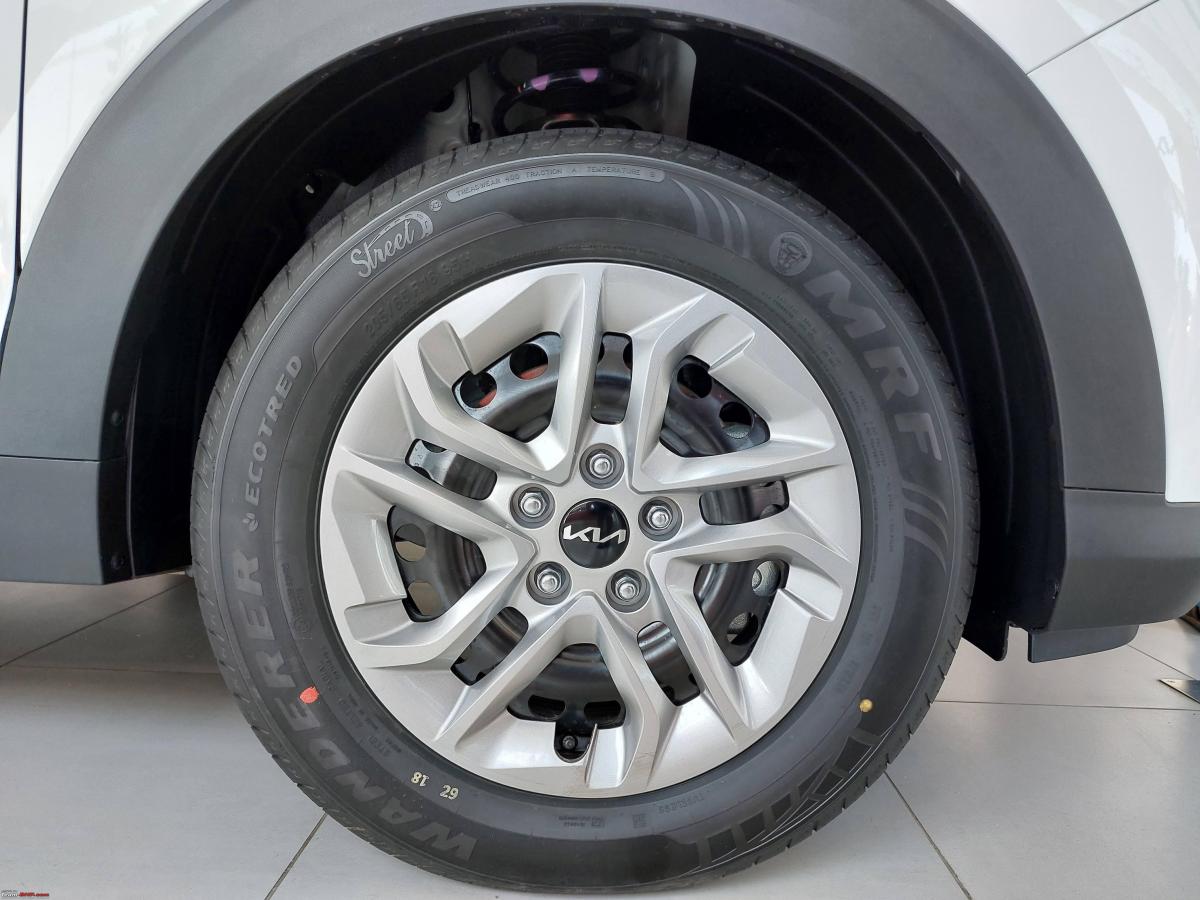
Handling: Very car like handling in the city, will be very easy for folks who are shifting from a hatch to the Carens. More interested in evaluating highway manners and rough road handling.
Cabin noise: While diesel engine whine does creep into the cabin, compared to the XL6, in cabin noise insulation is miles ahead. Noise from seepage outside the car is minimal, even when the music is off and it only gets better if you switch on music. A quick check of the door beading and the difference in quality is discernable, The Carens gets a thicker but soft door beading, which in combination with thicker door sheet metal (assuming this, given the heft of the door) helps isolate noise very effectively. Not sure how this would change on highways, but I would assume road noise would be minimal while there could be wind noise filtering through.
Premium feeling: The Carens definitely delivers across a wide range of parameters:
- Door panel heft - Doors feel a lot heavier than the XL6 and shut with a quiet thud.
- Seating comfort front row - Seats in the Carens are on the firmer side, which is to my liking as I believe it provides better support to your legs and back, which is important if you plan on doing long drives. While the white art leather seats in the Luxury spec Carens look + feel luxurious, black seats in the Prestige variant are equally comfortable, even if they do look a little drab. Compared to the XL6, under thigh support in the front seats are better while back support is probably on par since there doesn’t seem to be dedicated lumbar adjustment in either cars.
Black seats in the Prestige variant:

- Seating comfort 2nd row - Maybe the captain seats in the Carens are more comfortable, but the bench seat is a compromise IMO. I did not get a chance to experience the comfort in the captain seats but I did evaluate bench seat in the prestige variant and I wasn’t too happy with seating position and comfort. With the driver/passenger seat pushed back all the way, there is barely enough room for a 6 foot adult to sit in the 2nd row and the seating position ensures that your under thigh is raised, which might not be very comfortable during long drives. Carens is being considered by folks who travel with parents (based on the sample of people who were at the showroom today) and the seating position in the bench seat might not work for all. Further more, when you recline the seat, you body gets into a very weird angle (checked it myself and obsereved others reclining in the middle row) where it becomes a challenge to support your lower back. Hence anyone considering the 7 seater Carens, please do take extensive test drives with folks who would occupy the middle row before you decide to book the car.
- Seating comfort 3nd row - based on inputs from my son + my own experience, 3rd row comfort seems at par with the XL6 - both from a space and seating position point of view.
- Driver Seating position - You definitely sit higher than the XL6 and its easy to find a good driving position thanks to ample seat height adjustment and steering rake/reach adjustment. All round viewability is good and the slightly bigger(vs. XL6) OVRMs and IVRMs make it easier to evaluate surroundings.
- Tinted Windows - Both the Prestige and Luxury variants seem to have tinted windows, which should help control in cabin temperature. Also observed that the window glass is marginally thicker than the XL6, which again should help with noise insulation.
- Spacious - Front seats are positioned further apart, which results in more space between drive and passenger seat occupant. Especially important for big/tall folks with long hands.
Quality of plastics: Overall, plastic quality in the Carens is a lot better than the XL6.
Dashboard - Few notches above the quality in the XL6, both in the Luxury and Prestige variants. While Luxury variants have a blue grey textured finish with cream plastics providing a contrast, Prestige/Premium variants come with a black textured finish with cream plastics providing a contrast. Blue OR Black, it feel a lot more thicker and sturdier than the plastics used in the XL6.
Door panels - Well contoured, sturdier and more ergonomic vs the XL6. Grab handle like cavity + storage space for a phone, both of which are missing in the XL6. Even the lever for opening the door feels a lot more sturdier and easier to use vs the XL6.
Door panel - Prestige variant:
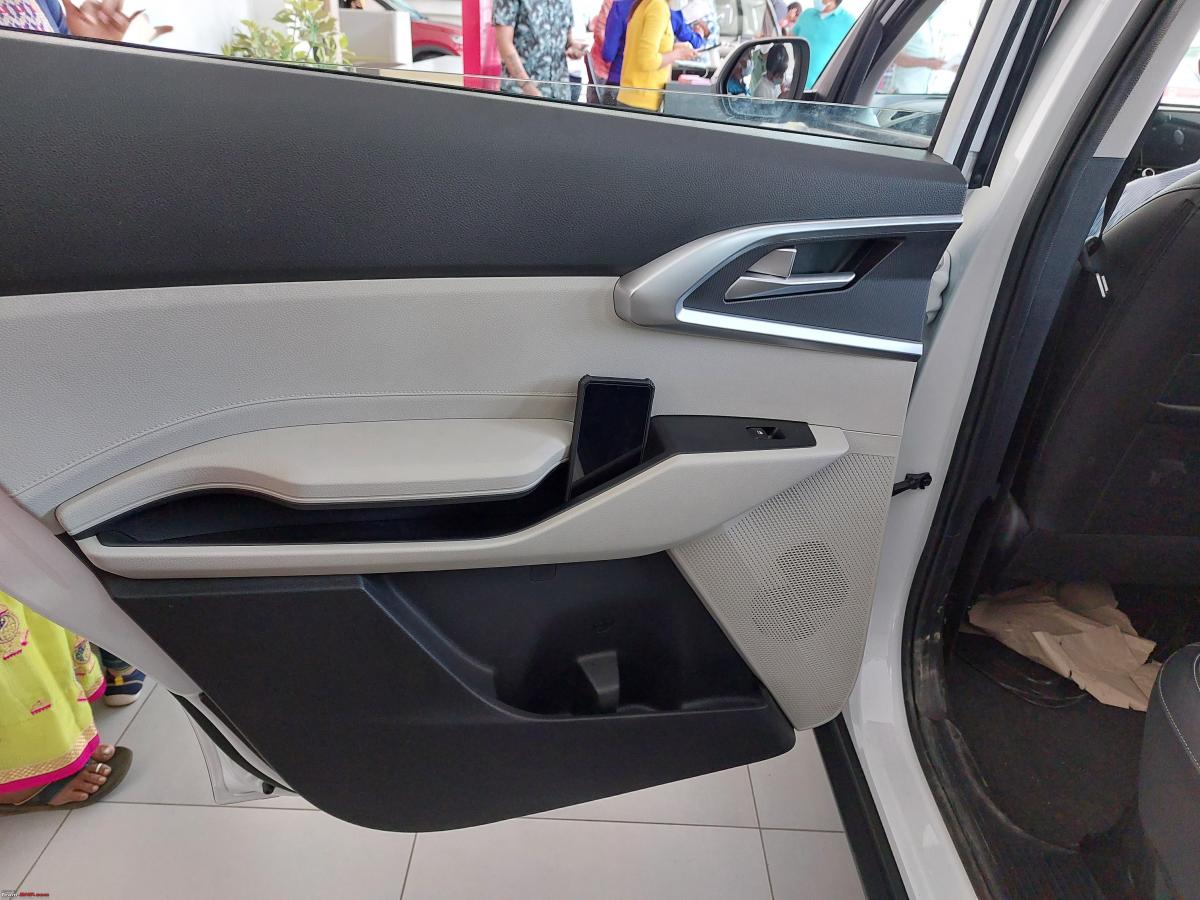
- Window control panel - again a couple of notches above XL6 as the window switches feel a lot more premium to use and don’t have this plasticky flex. Not sure if they are illuminate though.
- Steering Wheel - Controls on the steering of the Carens vs XL6 was a mixed bag for me. While the push buttons felt much better on the Carens, I find the rectangular adjustment buttons provided in XL6 easier to use for setting volume/Cruise Control vs. those provided on the Carens. Overall plastic quality of the steering wheel on the Carens is better than that of the XL6.
- Third row plastics - on par with Maruti as the panels are thinner, flex under pressure and have this very plasticky looking finish.
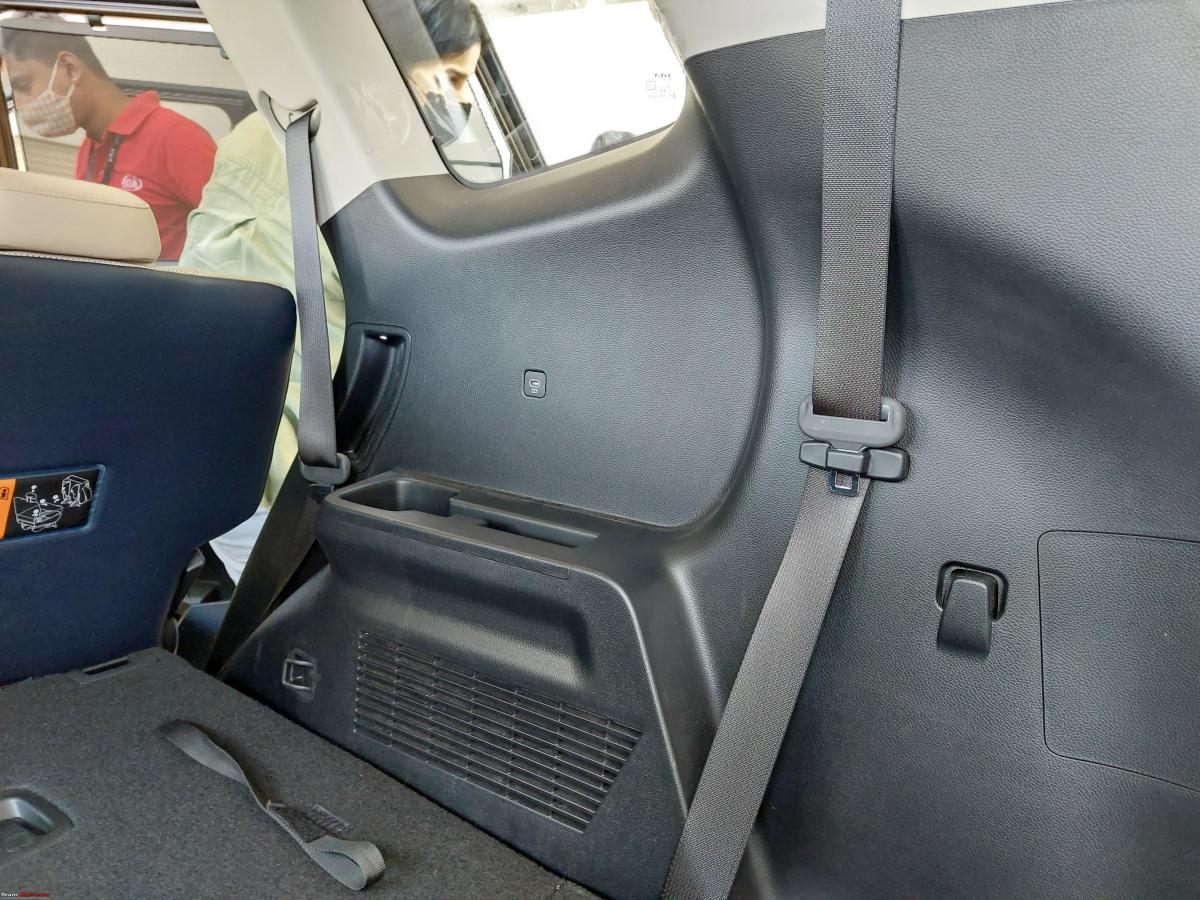
Other small things:
- Cramped engine bay - There is hardly any space in there vs the XL6 engine bay, which has ample space. Going to be hard to clean and access various components:
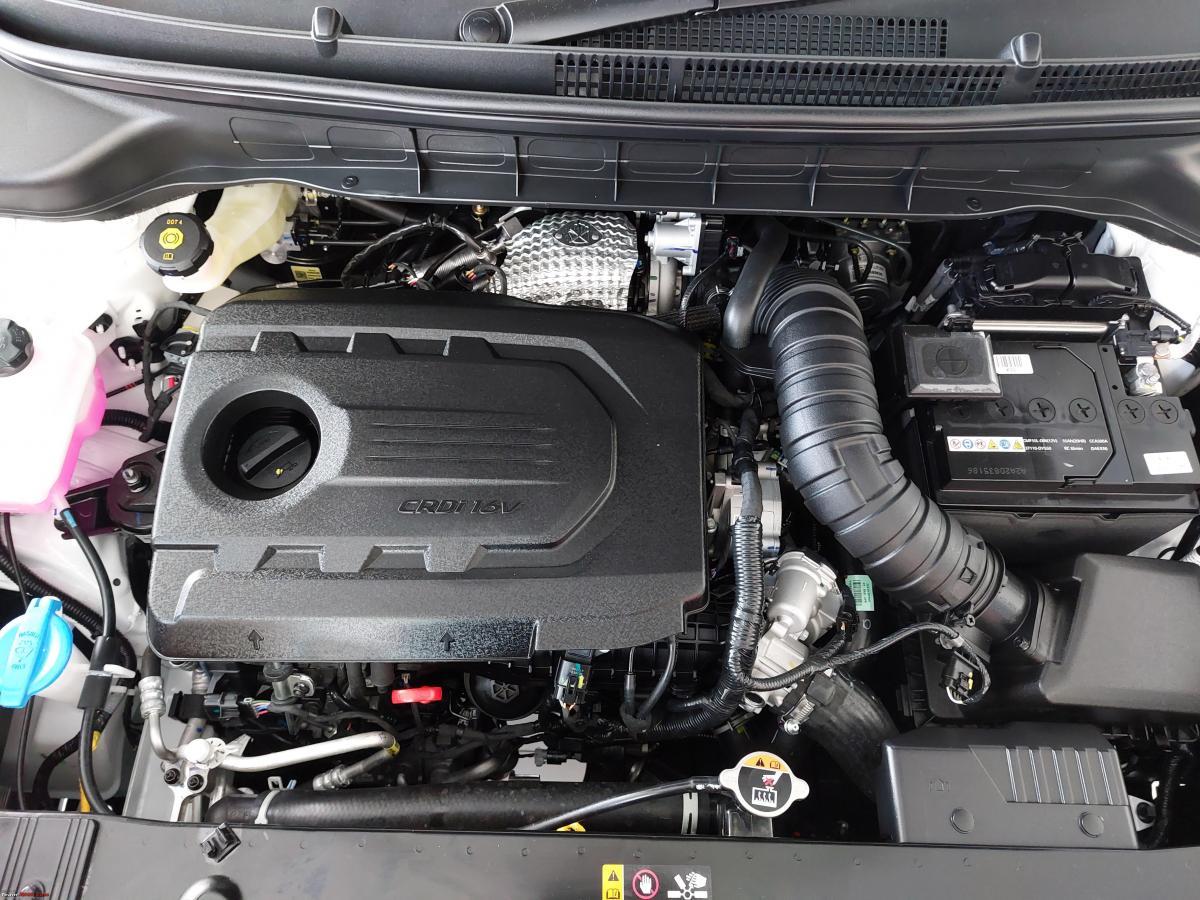
- Halogen Headlamps - A big plus for anyone purchasing the Premium/Prestige variants. Replace the halogen with a 90/100 Phillips + relay combination and you are all set for night/rain/fog. The 3 chamber LED headlamp + Fog lamp combination is definitely going to be a big letdown for all those who plan to invest in the higher end Carens:
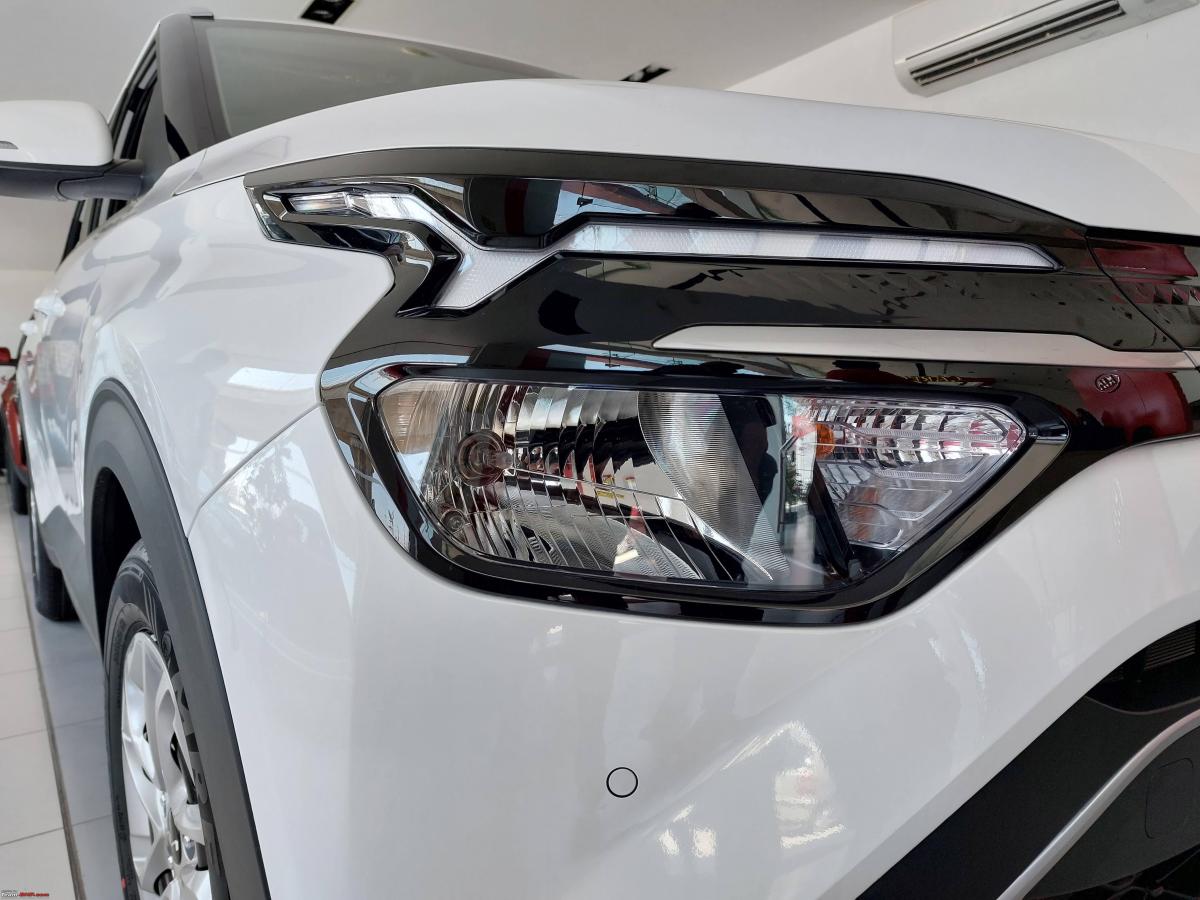
- Footwell space - Dead pedal positioning is very good and footwell space is comparable to the XL6. I do feel that it will get crowded in the footwell for people with large feet (I wear size 11 footwear), will need to drive a MT and check.
- Glossy black surfaces - Big turn off as these were layered with fingerprints and dust. I am definitely not a fan of the pattern on these surfaces and it might have been cheaper and more elegant, if Kia could replace these panels with textured grey panels.
- Seat height and recline adjustment levers - looks to be a direct lift from Maruti stable and are flimsy when compared to other plastics in the Carens:
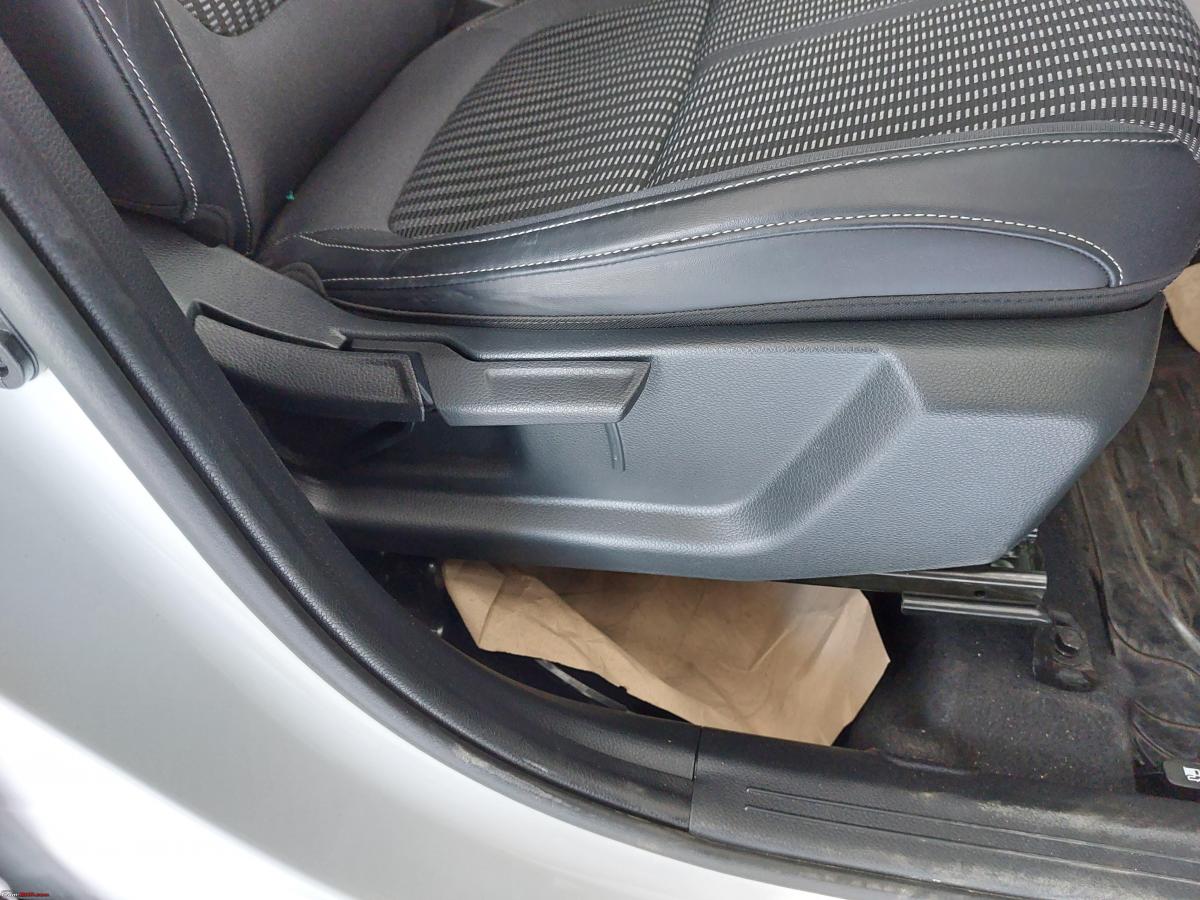
- Seatbelt adjustment - Absence of height adjustment in Premium and Prestige variants is a letdown.
- Rear wiper and defogger - Absence of rear wiper and defogger adjustment in Premium and Prestige variants is another letdown, but they do get rear camera and front + rear parking sensors:
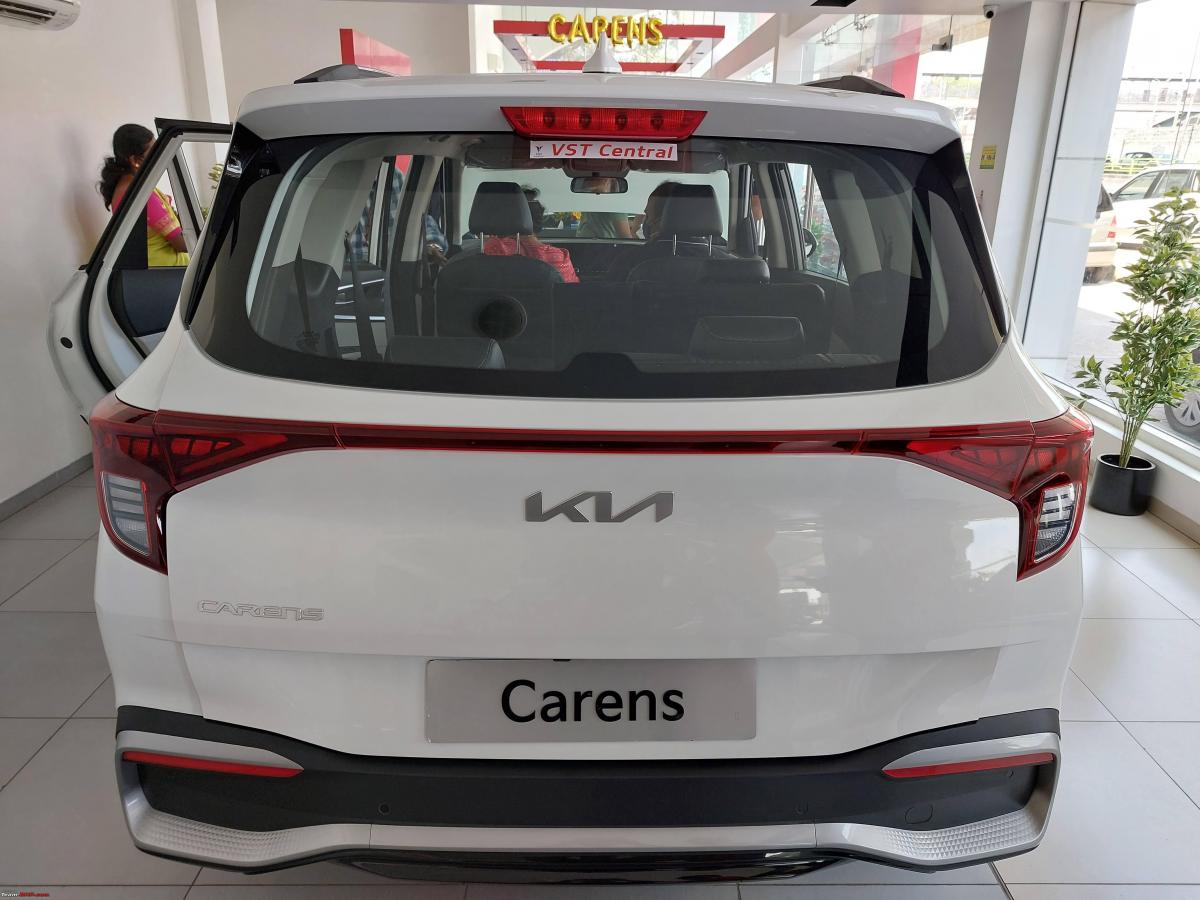
- Aircon controls - Very basic looking aric on controls in Premium and Prestige variants is another letdown:
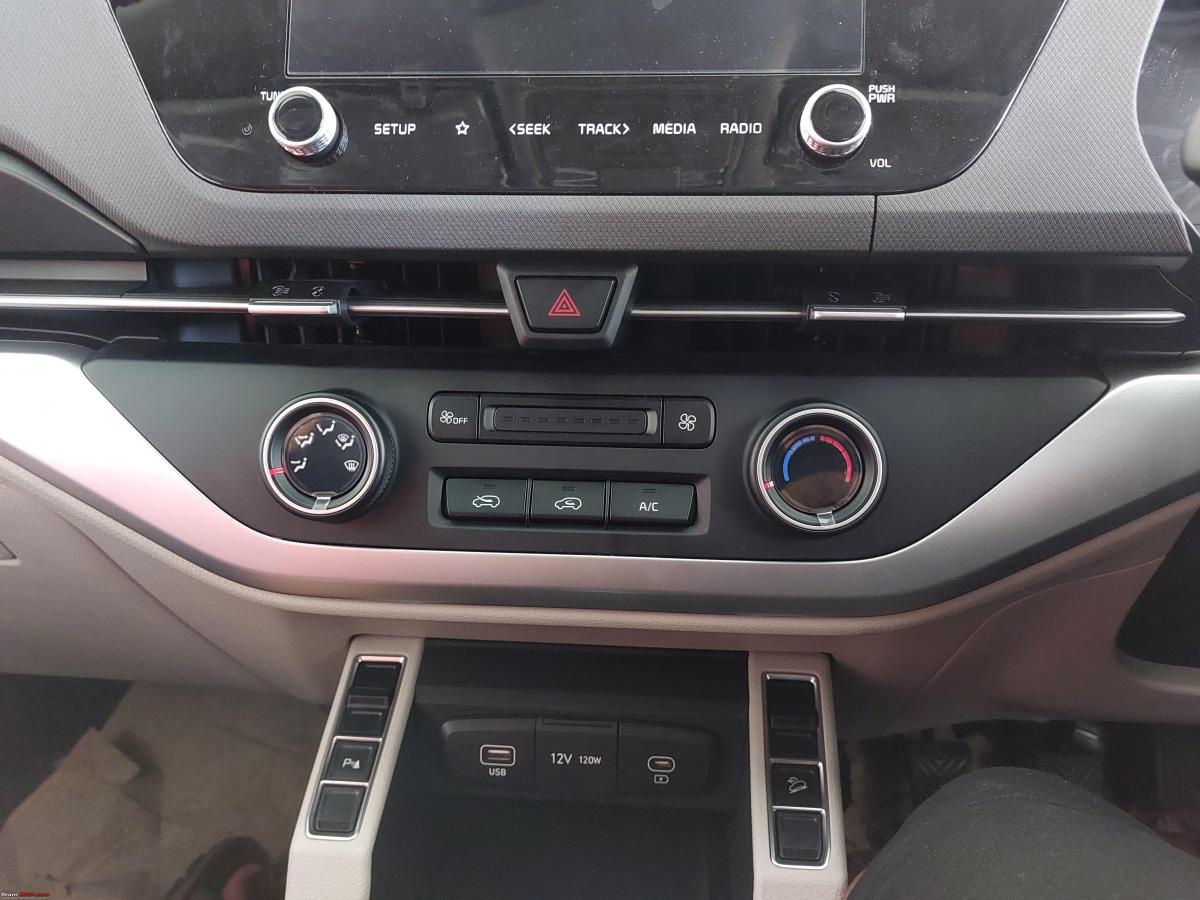
- No rattles - Absolutely no rattles in the test drive cars and given the solid feel of panels, I am not sure if they will develop rattles.
- Boot struts - Seem to be quiet sturdy and open the rear hatch in a very easy motion. Additionally, the weld joints around the boot door have a cleaner finish vs. XL6.
- Boot floor cover - seems a tad thinner than the XL6 covers and its not split, which would mean that you have to unload all items from the boot to lift the cover.
- Wheel cap - decent looking wheel cap on the 15 inch steel wheels. If you buy a Red Carens, you could paint the wheels red, should be a good contrast against silver caps.
- Smart key - thin elegant looking smart key provided in the higher variants while premium and prestige variants will not get keyless entry.
- Additional padding - boot door area gets additional padding, which I am assuming is in place to reduce noise and vibrations from the boot door:

So the big question is, If you are in the market for a petrol 6/7 seater under 15L, should you seriously consider the Carens? My answer would be a very strong yes. The 7 seater Prestige 1.5 MT variant is 12.4L OTR Bangalore vs. XL6 Zeta variant which is about the same price. The Carens seems to outshine the XL6 on many parameters and what needs to be evaluated is highway manners and braking, both of which I was unable to check since Kia showrooms are not providing long test drives of the Carens.
News
Brought home a Toyota Innova Crysta GX diesel AT
Despite the size, the Crysta is as easy to drive as a sedan in the city, and I was completely at ease finding the perfect driving position.
BHPian anand253 recently shared this with other enthusiasts.
Hello All,
Happy to let you know that I have recently taken possession of a 2.4 GX auto diesel in Garnet Red earlier this month. Thanks to all the contributors to this thread whose inputs helped me finalize my choice. What started out as a requirement for a second car due to offices restarting this year led me to consider many options:
Used: Was interested only in the T-badge here as I have never been a buyer in the used car market. Considered few options of the Yaris and Altis across Spinny & Ola, but somehow did not get the right vibes. The Crystas that I saw in U Trust and Spinny were highly priced, and I did not feel like spending 15-20 L for the high mileage ones that I saw. In the limited efforts that I made online, I also could not locate direct owners and that put this source to rest.
New: Considered Creta/ Alcazar/ Tucson as alternatives as we already have a sedan and wanted a more spacious and robust car for the roads that we have today. Between these, the Tucson was a serious alternative - the build quality, driving pleasure and overall fit and finish doesn't feel like a Hyundai at all . While I had commenced negotiations for the 2WD AT and was getting a good deal, the only nagging point was that we found the ride in the 4WD test vehicle bouncy, not sure if this was due to over inflated tyres or otherwise. The SA mentioned that he had taken this offloading with some potential buyers outside of Mumbai and hence a service was due.
In the meanwhile (this was mid Dec), we decided to take a test drive of the Crysta and took it through the same patches. Despite the size, the Crysta is as easy to drive as a sedan (this observation is spot on from the review) in the city and I was completely at ease finding the perfect driving position. While we did not honestly need the third row, as a package this made sense for us. Factors like ownership longevity (my current sedan is 9 yrs old), reliability (coming from a Hyundai) and comfortable drives tilted the decision in it's favour.
Purchase experience: Given the news of potential price hikes in 2022, I started shopping around with multiple dealers. Not surprisingly there was limited inventory with all dealers (chip shortages/ YE reductions etc. probably playing a key role) if you were specific of color and model. Finally closed the deal for a Nov 21 VIN that had just recently landed at dealer stockyard. After performing the Team BHP PDI, I paid in full by end Dec. Registration was completed in the first week of Jan and took possession later that week. The whole process was smooth, quick and professionally handled. I would be happy to recommend my SA at Lakozy to any one in Mumbai.
Accessories: Got the interiors done up like the top end, installed fogs, rear view camera and rear bike protector from the dealer. I plan to get underbody done during the first service and have ordered 7D mats from a dealer in Delhi who a fellow BHPian has tried out. I also got the engine cover ordered and installed prior to delivery.
Haven't driven the car much so far (400 kms), so will post updates as we go along.
Thanks to all the fellow owners. Cheers!
Check out BHPian comments for more insights and information.
News
Rumour: 7-seater Toyota C-MPV India launch in 2023
The new MPV could fill the gap between the Maruti Suzuki Ertiga and the Toyota Innova.
According to a media report, Toyota is likely to launch a new 7-seater C-MPV in 2023. It is said to be part of the brand's 'Big Leap' strategy.
It is believed that the C-MPV could fill the gap between the Maruti Suzuki Ertiga and the Toyota Innova. It will go up against the likes of the soon-to-be-launched Kia Carens.
While Toyota has kept details of the C-MPV under wraps, an earlier report suggests that the MPV could be based on a monocoque or unibody construction. A pure hybrid powertrain is rumoured to power the new model.
Besides the C-MPV, Toyota is also planning to introduce six new vehicles over the next 2 years, including a mid-size 5-seater SUV.
Source: ET Auto
News
Maruti Ertiga & XL6: How they cracked the Indian MPV segment
Only time will tell if the Kia Carens will be able to stand its ground in the segment, sandwiched between the Ertiga & the Toyota Innova Crysta.
BHPian pqr recently shared this with other enthusiasts.
How did Maruti crack the compact MUV code with Ertiga 2nd generation and its derivative XL6?
Key achievements of Ertiga 2nd generation in 2021:
- Petrol (+CNG) only Ertiga and extended product line - XL6 - together sold 1,54,310, which is the highest in its lifetime
- 2nd generation extended Ertiga product line, in 2021, sold more than twice as many as the 1st generation, ever in any calendar year
- The extended Ertiga product line has joined the esteemed club of 1,50,000+ cars in a year (Other members - Maruti 800, Maruti Alto, Maruti Baleno, Maruti Wagon R, Maruti Dzire, Maruti Swift, Hyundai i10)

- 2021 CNG only Ertiga 2nd generation (51,076) nearly matched best-ever diesel Ertiga sales (51,446)
- XL6 (39,902) has been quite successful on a standalone basis, it is standing just behind Ertiga and Innova in sales tally, even ahead of (half of its price) Renault Triber (32,766)
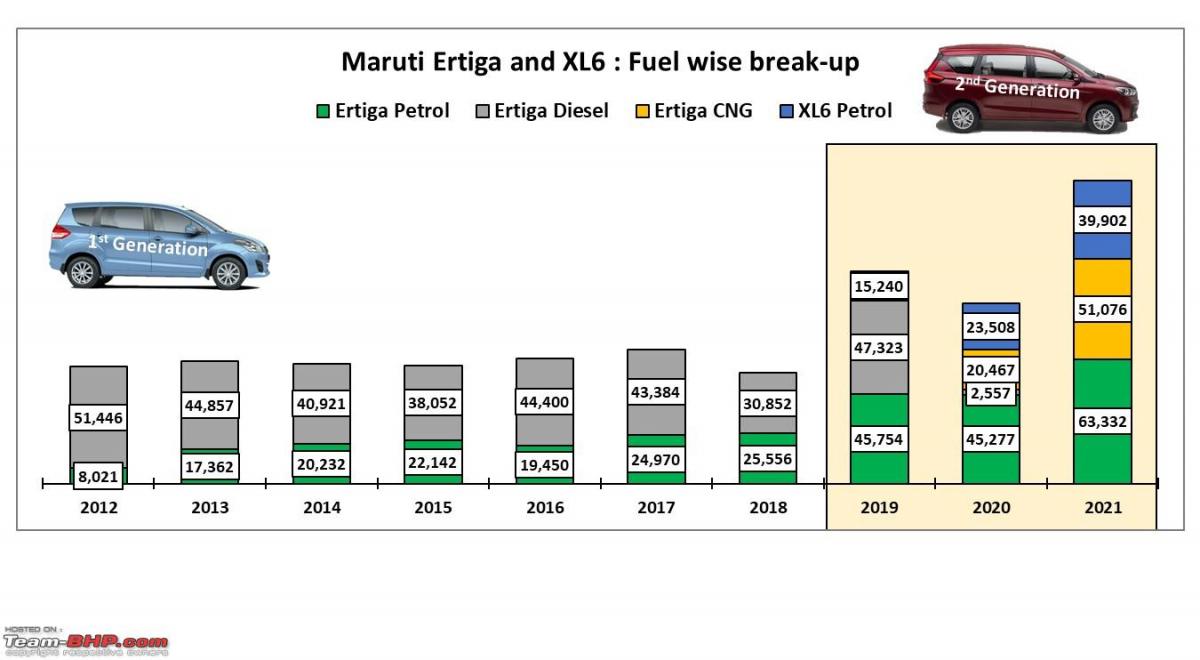
Tracing timeline
Introduced in 2012, Ertiga 1st generation was a definitive product in the Indian market. It is a MUV with monocoque construction, front-wheel drive arrangement, with a compact footprint, offering comfortable ingress and egress, and the option of a 1.4L petrol or a 1.3L FCA sourced diesel engine (in a higher state of power tune), mated to a 5-speed manual transmission and was wearing a very attractive price tag, starting from ₹ 5,89,000 (lower than executive sedans). It was having 2nd generation Swift inspired, but differentiated design, which was nice on the eyes. Similar to Toyota Innova, Ertiga 1st generation imbibes kinetic motion in design quite well, shunning conventional van like the boxy image of MPV. Ertiga 1st generation was sharing platform with 2nd generation Swift means it was having back end cost synergy as well. Ertiga 1st generation was quite a city friendly due to its compact footprint and car-like driving behaviour, which made it an instant hit among customers with extended families or in need of a versatile car for daily drive. Fleet operators too were happy to have an MPV with a much lower price tag than that of Toyota Innova.
By mid-2013, Maruti also introduced a CNG kit with dual ECU and gas-port injection for Ertiga (Lxi and Vxi variant), however, the SIAM library does not have a separate sales breakup between petrol and CNG, for 1st generation Ertiga.
Ertiga 1st generation’s facelift was introduced in 2015, and in came 4-speed torque convertor transmission for 1.4L petrol engine and the addition of starter-generator based mild-hybrid technology for 1.3L diesel engine. Sales always remained in 60,000+ territory throughout the lifecycle, with diesel commanding 60% of the mix.
2nd Generation Ertiga

2nd generation Ertiga was launched towards the end of 2018. 2nd generation Ertiga was having a new design direction with more conventional-looking headlamps and larger tail lamps that covers a larger rear area, quite a departure from 3rd generation Swift with which it shares a platform. Dimension wise, 2nd generation Ertiga was longer (+130mm), wider (+40mm), slightly taller (+5mm), with the same old wheelbase. New structure and sheet metal have added generous bulk at the right places.
2nd generation Ertiga came with a new 1.5L petrol engine (+12 bhp power and +8Nm torque) and the same 1.3L FCA sourced diesel engine, this time both the engines were coupled with starter-generator based mild-hybrid technology, though transmission options remained the same.
The price increase was in the range of ₹ 50,000 - ₹ 72,000 for petrol variants. All the variants received projector headlamps, LED tail lamps, mild-hybrid technology, 3rd-row seat recline function and coloured TFT MID.

For lower diesel variants price optically remain unchanged, despite the addition of projector headlamps, LED tail lamps and 3rd-row seat recline function for all diesel variants. The top two diesel variants (Zdi and Zdi+) saw an increase in price by ₹ 44,000 and ₹20,000, respectively, for the Auto AC feature.

Later in 2019, Maruti replaced FCA sourced diesel engine with its first in-house developed 1.5L BS4 diesel engine mated to an all-new 6-speed manual transmission, prices were ₹ 29,000 higher than the equivalent 1.3L diesel engine. Maruti also introduced a factory-fitted CNG kit for a 1.5L petrol engine (without mild-hybrid technology), only on the VXi variant and Tour M (for fleet operators), for an additional sum of ₹ 71,000 over a petrol-only engine. All new sets of engines were refined and fuel-efficient, in a typical Maruti way. However, Maruti has to discontinue the 1.5L diesel engine from 1st April 2020 as the BS6 upgraded engine prototype failed to meet BS6 emission regulation in internal testing due to some thermodynamics issues.
In 2019, GNCAP subjected Ertiga 2nd generation to a 40% frontal offset crash test. It received a 9.25 score (on a scale of 0-17) for adult occupant protection which translates into a 3-star rating and the body shell was found to be UNSTABLE. Not very remarkable performance on safety parameters, though.

With the 2nd generation Ertiga launch - full-year sales nearly doubled in 2019 (vs 2018) in an already depressed market. The year 2020 saw sales plunge to 91,000 mark, owing to COVID-19 induced pandemic, still, Ertiga+XL6 became the 6th best-selling passenger vehicle in the Indian market. Come 2021, despite all odds Ertiga+XL6 became the 5th best-selling passenger vehicle in the Indian market, with a stellar sales figure (1,54,310). CNG Ertiga 2nd generation launch has proved to be a game-changer for Maruti, as it largely filled the void created by diesel engine discontinuation.

Why the 2nd generation Ertiga with a petrol-only engine (+CNG) is more successful than the 1st generation Ertiga with petrol as well as diesel engine option?
The answer lies in the additional increase in length of 2nd generation Ertiga. 2nd generation Ertiga is 130 mm longer than 1st Generation Ertiga, though the wheelbase remains the same. That additional increase in length has gone in the rear overhang extension.

As a result, the third row of seats now have more legroom to offer than before and there is additional usable boot space of +74L. Maruti has added recline function to the 3rd-row backrest, thus making it more practical.
Now if one looks at the basic definition of a MUV: It is a category of vehicle meant to carry more passengers or more luggage or both together. Ertiga 1st generation was having little compromised 3rd row and was a little less usable for carrying more passengers in comfort or more luggage at the same time. This never worked that well for the fleet operators - one of the major target segments. With 2nd generation Ertiga, the fleet operators can easily fit in adult passengers in reasonably acceptable comfort levels. Same way, family segment customers can have, adults too, seated in reasonable comfort for a given budget (those who cannot afford Innova). Value was unlocked by the 2nd generation Ertiga and that resulted in very good sales traction.
Introduction of XL6: A clever derivative

XL6 is Ertiga 2nd generation’s outdoorsy crossover version, with lots of cosmetic upgrades inside-out. In marketing terminology, this concept is known as product line extension.
XL6 gets captain seats in the second row replacing the bench seat of Ertiga, an all-black interior theme with a better quality roof liner, redesigned bumpers, revised bonnet line and roof rails. In terms of features, it gets new LED headlamps, DRL, tail lamp, cruise control, auto headlamps, and leatherette seat covers, over Ertiga’s usual features list. For XL6, Maruti just black painted 15” silver alloy wheels of Ertiga, a design change and size upgrade could have been a better differentiator, though. Mechanically it remained the same. Increased on paper dimensions (length and width) over regular Ertiga is all due to protruding body cladding and reprofiled bumper and there is no change in-cabin space. Sold through the Nexa network, Maruti is trying to build a premium brand identity for XL6 over regular Ertiga. It is mostly targeted towards the chauffeured driven segment, who seek the luxury of captain seats, somehow it works quite well in India. Maruti is charging a price premium of ₹ 48,000 to ₹ 68,000, for Delta and Alpha variants of XL6 over Zxi and Zxi+ variants of Ertiga 2nd generation, respectively. Maruti claims, that, they and their vendors have jointly invested ₹ 100 crores in the development of XL6.
XL6 actually picked up immediately and added incremental monthly sales of 3,000 units to the Ertiga product line. For relative reference, 1st generation Ertiga was selling around 5,000 units on a monthly average basis. Now that is quite a figure for highly synergized investments.
Competition
Many manufacturers tried to emulate Ertiga 1st generation recipe, in past, to gain volume and success. Forget about their success, rather, they failed miserably and had to discontinue their MUV product line completely, that too within 4 years span.
Chevrolet Enjoy (2013-2017)
SAIC has had slipped in the RHD version of its Chinese product - Wuling Hongguang S - as its third product in India, under the Chevrolet badge, and named it ‘Enjoy’. It was a rear-wheel-drive, monocoque construction with the boxy rear end and age-old interiors from the 90s. It did undercut Ertiga’s pricing at the time of introduction but later reached the same level. By setting contemporary Maruti Ertiga as a benchmark, the Indian target audience decided not to compromise on value by paying the same amount asked for Chevrolet Enjoy. So Enjoy turned out to be a flop.
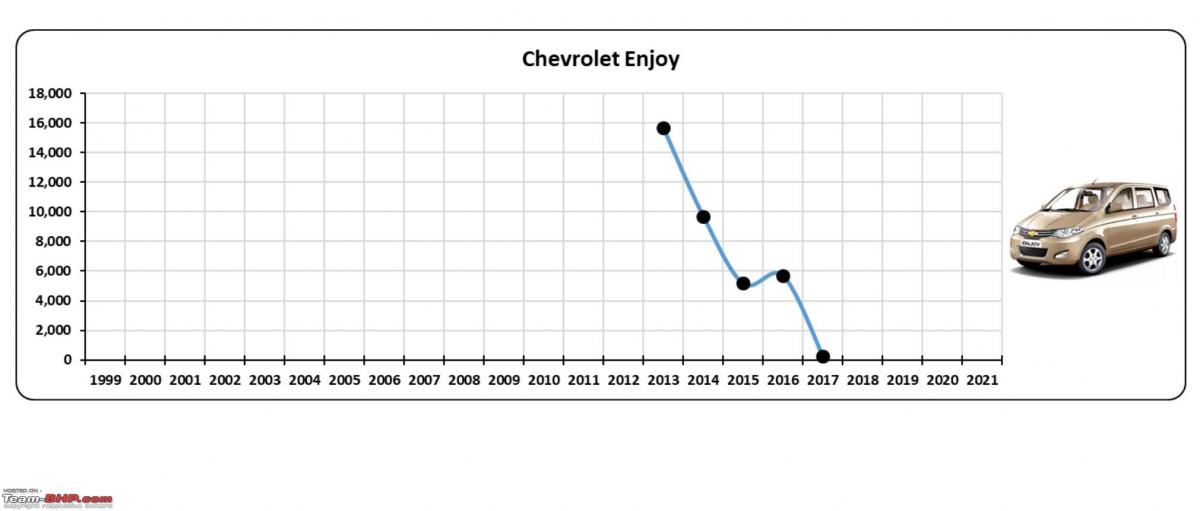
Honda Mobilio (2014-2017)
Mobilio was having an edge over Ertiga in terms of engine performance, and space was nearly at par. But then Honda tried to command a hefty brand premium in price (₹ 80,000+), and the customer didn’t accept Mobilio at such a price point with a sub-par interior from Brio. Honda initially was quite lazy and didn’t even try to differentiate Mobilio from Brio and Amaze which were having the same front design. Honda Mobilio was a massive flop.
But somehow it didn’t deter Honda India, they brought in some sort of jacked-up crossover version of Mobilio, with Honda City inspired front, developed in Thailand primarily for the ASEAN market and called it BRV (Bold Runabout Vehicle), whatever that name means in Honda world. Honda was trying to build SUV the brand identity for BRV and pitted it against Hyundai Creta, but the brand image created in the mind of Indian customers was that of a crossover version of Mobilio (due to near-identical side profile), result - another big flop from Honda India.

Renault Lodgy (2015-2019)
Renault was aiming for Toyota Innova with rebadged European Dacia Lodgy for the Indian market. It was having K9K series diesel engine option in two states of tune, to target both fleet operators and family segment, buyers. But then target customers compared it with the Ertiga as a benchmark, not Toyota Innova as intended by Renault India, and Lodgy started looking expensive, without much value. The worst part – is it looks like an ambulance and nobody wants to buy an ambulance to ferry their family. Renault Lodgy was a big flop.

There were unconfirmed reports of Hyundai starting a compact MUV project way back in 2012 to rival Ertiga 1st generation but later abandoned it in due course of time, due to an unmet cost target.
The project was recently revived by KIA with Carens (a bigger vehicle than Ertiga 2nd generation), as there is a good chance of higher volume potential and cost synergy among both the brands. Positioning will be clear once prices are out in the coming months.
Has Maruti Ertiga 2nd generation nearly killed Mahindra Marazzo (2018-)?
Compared to Ertiga 2nd generation – Mahindra Marazzo is bigger on the external dimension, with a relatively more powerful diesel engine, and a GNCAP safety rating of 4 Star (Ertiga scored 3 Star), relatively premium interior feel, also it is priced in the sweet spot - between Ertiga and Innova, more so by maintaining a safe distance from Innova. Mahindra does have a network and pedigree of selling people movers across the length and breadth of the country, a large majority of hinterland relies on Mahindra or Force Motors for cheap small scale proper public or commercial transport vehicles.

Going by these on paper facts, it seems like Mahindra was having the right set of ingredients for a successful recipe. But it turned out otherwise. 2nd generation Ertiga was launched towards the end of 2018, just after the launch of Mahindra Marazzo, and Marazzo lost steam immediately afterwards. Sales could not even cross the 20,000 mark ever in any given calendar year, even ugly looking Mahindra Xylo crossed the 30,000 mark at the beginning of its lifecycle. What gives?

The answer lies in, the attributes, buyers keenly look for in an MPV. To start with, the third row of Mahindra Marazzo offers relatively less space and seating comfort in comparison to Maruti Ertiga 2nd generation, and it goes against the primary attribute buyers look for in an MPV. After taking a seat in the third row of Marazzo, right after Ertiga, space difference and seating comfort level become a little more apparent. With the reclining third row of the seat’s backrest, larger side glass panel, Ertiga 2nd generation feels more spacious, practical and airy, thus taking away the cake here.

Marazzo’s boot space figure is marginally less on papers but is significantly affected on practicality, due to loading lip and vertical orientation, whereas Ertiga’s boot floor is flat with respect to loading lip (due to false flooring) and offer a larger base for luggage storage, thus Ertiga being more accommodating and practical.
Mahindra has also gone for complex platform architecture for Marazzo. Whereas Ertiga has a simple monocoque FWD platform shared with other Maruti products for cost synergy, Marazzo has ladder frame underpinnings with FWD transverse engine architecture (thus no propeller shaft). It is quite unique as ladder frame chassis conventionally have RWD biased propulsion system. Seems like a hybrid architecture to have the goodness of both the world. But financially Mahindra has killed the cost synergy somewhere. Moreover, the dashboard intrudes too much inside the cabin and eats up in-cabin space. Also, the engine bay is too cramped for regular maintenance work. Seems like a case of misplaced packaging due to a lack of harmony between designers and engineers at Mahindra.
The overall value proposition offered by Marazzo for customers gets distorted, as the top-end Marazzo M6+ BS6 diesel variant is ₹4,78,000 and ₹ 4,10,000 (ex-showroom price level) more expensive than Maruti Ertiga Zxi+ and Maruti XL6 Alpha BS6 petrol manual variants, respectively, but offers less practical space in the third row. A high price gap of ₹ 4,78,000 at the ex-showroom level, offsets the diesel advantage of Mahindra Marazzo over BS6 petrol Ertiga. CNG Ertiga is priced at ₹ 9,87,500, here works as icing on the cake, as it is much cheaper to own and run, wherever CNG filling station network is good, and becomes a favourite choice among the fleet operators.
At the same time, Maruti is also keeping a strong check on prices, though virtually it has no direct competition right now, in the given price band. It seems, Maruti knows the price elasticity curve would not be favourable in its case, unlike for Toyota Innova, where price has gone up with time and so is the volume.
Does lack of automatic transmission or petrol engine reduce Marazzo’s potential further? Maybe yes, for family-oriented buyers, but may not be for fleet operators, later also being a big target segment.
Mahindra has benchmarked Marazzo against Toyota Innova (based on test mule images) and maintained a safe price gap, but never imagined in foresight that Maruti can take an incremental step for betterment, in the form of 2nd generation Ertiga and destroy the whole armour. For now, the presumed to be a sweet spot for Mahindra Marazzo in 2018, turns out, to be between a rock (Maruti Ertiga) and a hard place (Toyota Innova).
Only time will tell if KIA succeeds to make a place for Carens, sandwiched between Maruti Ertiga and Toyota Innova, with typical Hyundai/KIA’s traditional strength of long features list and diverse drivetrain option, or meet the fate of other not so successful challengers.
Conclusion
Market sizing
Market size for a new product always depends on the value proposition of the offering. Looking at 1st generation Ertiga’s sales number, anyone would assume 60,000+ market size, even for future product planning. However, an altered value proposition has unlocked higher market potential, even without a diesel engine. So market sizing exercise size should be very thoughtful.
Customer/Consumer Need analysis
- Customer/consumer’s unfulfilled needs to be explored in-depth and addressed before emulating ingredients and recipe of a successful competitor’s product, a basic tenet to success.
- Exterior Dimension and packaging – myth buster
- External dimension figures, may, may not be, the right proxy for real in-cabin or boot space. Real-world practicality needs to be always judged in person and validated during the product development phase. Hyundai Alcazar (2760mm) has a 10mm longer wheelbase than Toyota Innova (2750mm). Does that makes Alcazar offer more space in the second row or the third row, answer is, no! Dimension on paper can be deceptive.
- Harping on Creta’s success, Hyundai has gone for a product line extension in the form of a 6/7 seater Alcazar, to enter white space, with back end cost synergy. Hyundai Alcazar has already lost some of the market traction as of now, as Hyundai messed up with the 2nd and 3rd row of seating space, which rivals like Tata Safari do offer a better value at a justifiable price premium, except features though. In addition, Hyundai deliberately chose an underpowered, but more efficient 1.5L diesel engine, seems like an attempt to protect Tucson with a 2L diesel engine from complete cannibalization? The wrong choice again, as Tucson is not going to bring in volumes anyways, largely due to Hyundai’s brand elasticity limit, and Alcazar will suffer, as competitors do offer a more powerful diesel engine in that price band.
Price elasticity
- Price elasticity judgement is highly necessary, it is always safe to start at the lower price tag and gradually increase price based on the success of the product (like MG Astor and Mahindra XUV 700), rather than offering discounts in the early stage (like Skoda Kushaq). Not every product can have inelastic demand like - Toyota Innova, Fortuner and Hyundai Creta.
Check out BHPian comments for more insights and information.
Pages


























